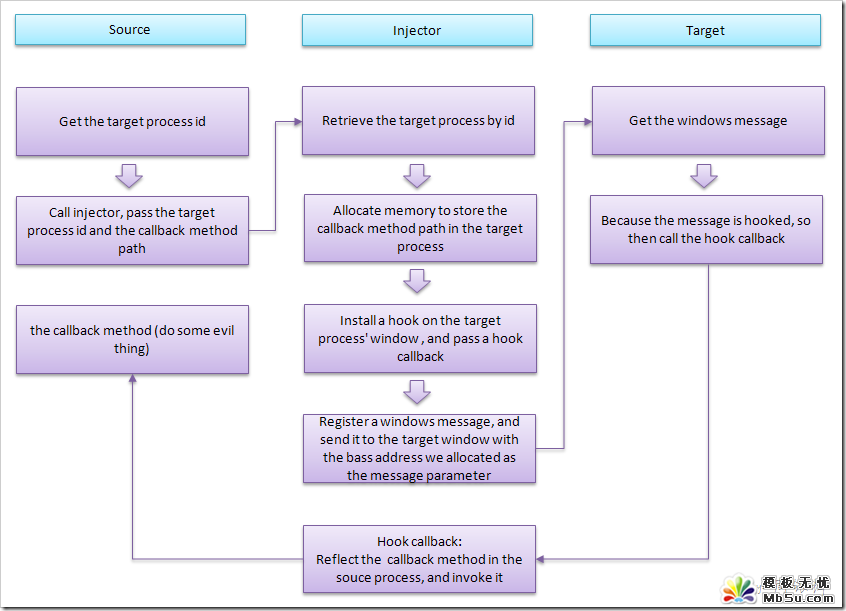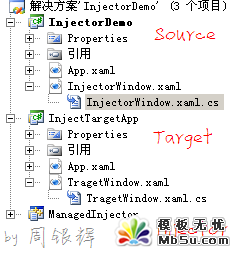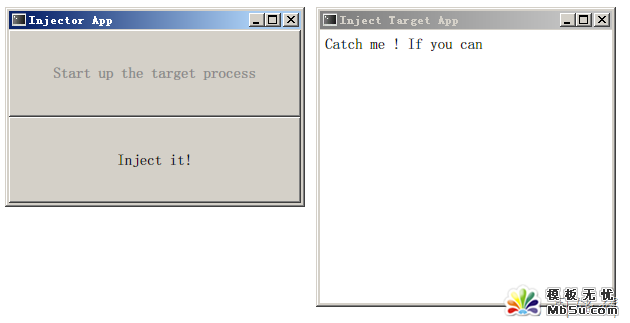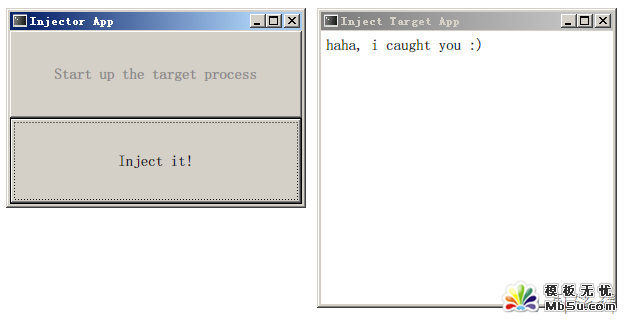怎樣實(shí)現(xiàn).net程序的進(jìn)程注入_.Net教程
推薦:如何在.NET環(huán)境下為網(wǎng)站增加IP過(guò)濾功能華能集團(tuán)下某發(fā)電廠的企業(yè)網(wǎng)站(基于Asp.Net2.0實(shí)現(xiàn),不允許修改源程序)要求實(shí)現(xiàn)廠內(nèi)用戶可直接訪問(wèn)整個(gè)站點(diǎn)的所有頁(yè)面,廠外用戶只能訪問(wèn)指定的頁(yè)面的功能,本文將按照需求分析、方案設(shè)計(jì)、編碼實(shí)現(xiàn)、部署應(yīng)用的順序逐步闡述整個(gè)解決方案的形成過(guò)程。 1.
進(jìn)程注入比較常見(jiàn),比如用IDE調(diào)試
大致原理是這樣的:
源進(jìn)程(也就是你的代碼所在的進(jìn)程)獲得目標(biāo)進(jìn)程(也就是你的注入目標(biāo)所在的進(jìn)程)的ID或進(jìn)程對(duì)象
源進(jìn)程提供一回調(diào)函數(shù)methodA(也就是你想要注入到目標(biāo)進(jìn)程后所執(zhí)行的代碼)
將目標(biāo)進(jìn)程和回調(diào)函數(shù)methodA的完整路徑(其所在的Assembly,Classic以及MethodName)提交給Injector(也就是我們編寫(xiě)的負(fù)責(zé)注入的類),讓Injector來(lái)完成注入和讓目標(biāo)進(jìn)程執(zhí)行回調(diào)函數(shù)
Injector根據(jù)提供的目標(biāo)進(jìn)程ID取得目標(biāo)進(jìn)程對(duì)象,并獲得目標(biāo)進(jìn)程的一個(gè)線程(我們稱為目標(biāo)線程)
在目標(biāo)線程中分配一塊內(nèi)存,將回調(diào)函數(shù)methodA的完整路徑作為字符串存入該內(nèi)存中
Injector在目標(biāo)進(jìn)程中安裝一個(gè)鉤子(Hook)監(jiān)視某一個(gè)Windows消息(messageA),撰寫(xiě)鉤子的回調(diào)函數(shù)methodB(該方法中的內(nèi)容稍后解釋)
像目標(biāo)進(jìn)程發(fā)消息messageA,并將剛才分配的內(nèi)存的基地址作為消息參數(shù)傳遞.
由于我們針對(duì)messageA安裝了鉤子,所以目標(biāo)進(jìn)程會(huì)調(diào)用我們鉤子函數(shù)methodB,并會(huì)把分配的內(nèi)存的基地址包含在函數(shù)參數(shù)中
下面這個(gè)圖可能會(huì)幫助你理解上面的話:

圖片看不清楚?請(qǐng)點(diǎn)擊這里查看原圖(大圖)。
#include "stdafx.h"
#include "Injector.h"
#include <vcclr.h>
using namespace ManagedInjector;
//defines a new window message that is guaranteed to be unique throughout the system.
//The message value can be used when sending or posting messages.
static unsigned int WM_GOBABYGO = ::RegisterWindowMessage(L"Injector_GOBABYGO!");
static HHOOK _messageHookHandle;
//-----------------------------------------------------------------------------
//Spying Process functions follow
//-----------------------------------------------------------------------------
void Injector::Launch(System::IntPtr windowHandle, System::Reflection::Assembly^ assembly, System::String^ className, System::String^ methodName) {
System::String^ assemblyClassAndMethod = assembly->Location + "$" + className + "$" + methodName;
//convert String to local wchar_t* or char*
pin_ptr<const wchar_t> acmLocal = PtrToStringChars(assemblyClassAndMethod);
//Maps the specified executable module into the address space of the calling process.
HINSTANCE hinstDLL = ::LoadLibrary((LPCTSTR) _T("ManagedInjector.dll"));
if (hinstDLL)
{
DWORD processID = 0;
//get the process id and thread id
DWORD threadID = ::GetWindowThreadProcessId((HWND)windowHandle.ToPointer(), &processID);
if (processID)
{
//get the target process object (handle)
HANDLE hProcess = ::OpenProcess(PROCESS_ALL_ACCESS, FALSE, processID);
if (hProcess)
{
int buffLen = (assemblyClassAndMethod->Length + 1) * sizeof(wchar_t);
//Allocates physical storage in memory or in the paging file on disk for the specified reserved memory pages.
//The function initializes the memory to zero.
//The return value is the base address of the allocated region of pages.
void* acmRemote = ::VirtualAllocEx(hProcess, NULL, buffLen, MEM_COMMIT, PAGE_READWRITE);
if (acmRemote)
{
//copies the data(the assemblyClassAndMethod string)
//from the specified buffer in the current process
//to the address range of the target process
::WriteProcessMemory(hProcess, acmRemote, acmLocal, buffLen, NULL);
//Retrieves the address of MessageHookProc method from the hintsDLL
HOOKPROC procAddress = (HOOKPROC)GetProcAddress(hinstDLL, "MessageHookProc");
//install a hook procedure to the target thread(before the system sends the messages to the destination window procedure)
_messageHookHandle = ::SetWindowsHookEx(WH_CALLWNDPROC, procAddress, hinstDLL, threadID);
if (_messageHookHandle)
{
//send our custom message to the target window of the target process
::SendMessage((HWND)windowHandle.ToPointer(), WM_GOBABYGO, (WPARAM)acmRemote, 0);
//removes the hook procedure installed in a hook chain by the SetWindowsHookEx function.
::UnhookWindowsHookEx(_messageHookHandle);
}
//removes a hook procedure installed in a hook chain by the SetWindowsHookEx function.
::VirtualFreeEx(hProcess, acmRemote, buffLen, MEM_RELEASE);
}
::CloseHandle(hProcess);
}
}
//Decrements the reference count of the loaded DLL
::FreeLibrary(hinstDLL);
}
}
__declspec( dllexport )
// The procedure for hooking, this will be called back after hooked
int __stdcall MessageHookProc(int nCode, WPARAM wparam, LPARAM lparam) {
//HC_ACTION: indicate that there are argments in wparam and lparam
if (nCode == HC_ACTION)
{
CWPSTRUCT* msg = (CWPSTRUCT*)lparam;
//when the target window received our custom message
if (msg != NULL && msg->message == WM_GOBABYGO)
{
//get the argument passed by the message
//actually, the argument is the base address (a pointer)
//of the assemblyClassAndMethod string in the target process memory
wchar_t* acmRemote = (wchar_t*)msg->wParam;
//gcnew: creates an instance of a managed type (reference or value type) on the garbage collected heap
System::String^ acmLocal = gcnew System::String(acmRemote);
//split the string into substring array with $. Under this context:
//acmSplit[0]:the assembly's location
//acmSplit[1]:className;
//acmSplit[2]:methodName
//we use these infomation to reflect the method in the source assembly, and invoke it in the target process
cli::array<System::String^>^ acmSplit = acmLocal->Split('$');
//refect the method, and invoke it
System::Reflection::Assembly^ assembly = System::Reflection::Assembly::LoadFile(acmSplit[0]);
if (assembly != nullptr)
{
System::Type^ type = assembly->GetType(acmSplit[1]);
if (type != nullptr)
{
System::Reflection::MethodInfo^ methodInfo =
type->GetMethod(acmSplit[2], System::Reflection::BindingFlags::Static | System::Reflection::BindingFlags::Public);
if (methodInfo != nullptr)
{
methodInfo->Invoke(nullptr, nullptr);
}
}
}
}
}
return CallNextHookEx(_messageHookHandle, nCode, wparam, lparam);
}接下來(lái),做個(gè)DEMO嘗試一下:

解決方案中的InjectorDemo就是我們上述的源進(jìn)程,它會(huì)利用Injector將下面這段代碼注入到Target進(jìn)程中并執(zhí)行:
public static void DoSomethingEvie()
{
vartargetWindow = Application.Current.MainWindow;
if(targetWindow != null)
{
varlb = newLabel{Content = "haha, i caught you :)"};
targetWindow.Content = lb;
}
}
也就是說(shuō)InjectorDemo進(jìn)程會(huì)將InjectTargetApp進(jìn)程的主窗口的內(nèi)容修改成"haha, i caught you"這樣的一個(gè)Label.
運(yùn)行程序:

圖片看不清楚?請(qǐng)點(diǎn)擊這里查看原圖(大圖)。
上面的兩個(gè)窗口分別處于不同的進(jìn)程中, 點(diǎn)擊 "Inject it" 按鈕, 其輝調(diào)用如下代碼:
ManagedInjector.Injector.Launch(targetProcess.MainWindowHandle, typeof(InjectorWindow).Assembly, typeof(InjectorWindow).FullName, "DoSomethingEvie");
然后:

圖片看不清楚?請(qǐng)點(diǎn)擊這里查看原圖(大圖)。
分享:淺談使用ASP.NET Global.asax 文件Global.asax文件,有時(shí)候叫做ASP.NET應(yīng)用程序文件,提供了一種在一個(gè)中心位置響應(yīng)應(yīng)用程序級(jí)或模塊級(jí)事件的方法。你可以使用這個(gè)文件實(shí)現(xiàn)應(yīng)用程序安全性以及其它一些任務(wù)。下面讓我們?cè)敿?xì)看一下如何在應(yīng)用程序開(kāi)發(fā)工作中使用這個(gè)文件。 概述 Global.asax位于
- asp.net如何得到GRIDVIEW中某行某列值的方法
- .net SMTP發(fā)送Email實(shí)例(可帶附件)
- js實(shí)現(xiàn)廣告漂浮效果的小例子
- asp.net Repeater 數(shù)據(jù)綁定的具體實(shí)現(xiàn)
- Asp.Net 無(wú)刷新文件上傳并顯示進(jìn)度條的實(shí)現(xiàn)方法及思路
- Asp.net獲取客戶端IP常見(jiàn)代碼存在的偽造IP問(wèn)題探討
- VS2010 水晶報(bào)表的使用方法
- ASP.NET中操作SQL數(shù)據(jù)庫(kù)(連接字符串的配置及獲取)
- asp.net頁(yè)面?zhèn)髦禍y(cè)試實(shí)例代碼
- DataGridView - DataGridViewCheckBoxCell的使用介紹
- asp.net中javascript的引用(直接引入和間接引入)
- 三層+存儲(chǔ)過(guò)程實(shí)現(xiàn)分頁(yè)示例代碼
- 相關(guān)鏈接:
- 教程說(shuō)明:
.Net教程-怎樣實(shí)現(xiàn).net程序的進(jìn)程注入
 。
。